 | E-mail to Birds Korea |
 | KWBS |
in the Region
 | The Oriental Bird Club |
 | BirdLife International (Asia) |
August
Typically hot and humid (with day maxima often around 30°C), with occasional heavy rains and strong winds, associated either with southern typhoons or caused by the mix of humidity and heat.
Chinese Egrets become rather more widespread along the west coast. Shorebirds (including a very small number of Spoon-billed Sandpiper and at least in 2012 and 2013 several “White-faced Plover”) begin to build up in number at a few of the remaining best sites. Numbers tend to be rather lower than in spring, though Kentish Plover and Terek Sandpiper can be found in the thousands at a few sites. In open sea areas, August is often the best month to see Swinhoe’s Storm Petrel from commercial ferries, and towards the end of the month large numbers of Common Tern are also on the move, along the East Coast and in the Yellow Sea, sometimes joined by other tern species. On land, parties of Black-naped Orioles, the appearance of returning leaf warblers (especially Eastern Crowned and Arctic Warblers) and small numbers of Brown Shrike and Yellow-rumped and Brown Flycatchers by mid-month also hint at the start of passerine migration. At the very end of August, the first migrant Pechora Pipit (most likely of the subspecies menzbieri) and early migrant buntings also start to appear on offshore islands. National rarities recorded several times in August include Common Ringed Plover, Sooty Tern, Black Tern and Lesser Frigatebird. National firsts since 2000 have included Sooty Shearwater (2002), Aleutian Tern and Great Frigatebird (both in 2004) and Western Sandpiper (2012).
Gunsan-Jeonju, August 29 - 31
Three days were spent in the field, in weather that was calm and mostly sunny, with temperatures ranging from c.20°C as minima to 29-30C as daily maxima. On August 29th, the afternoon was spent at the Geum Estuary, near the barrage and then on Yubu Island for high tide (with 45,000 shorebirds and no other people at the latter site!); on the 30th, we then took a day-trip out to Eocheong to look for early autumn migrants; and on the 31st, we checked some woodland and a couple of reservoirs near Gunsan, before rechecking the barrage area and then visiting a river near Jeonju. In all, approximately 120 species were logged, including several fascinating ID challenges (at least two of which are the focus of articles on the highly informative Dig Deep website), and some excellent highlights that included:
- Garganey Anas querquedula. A total of 103 were counted in one scan of Ognyeo Reservoir on 31st. This appears to be the highest post-2000 site- and day-count in the ROK known to Birds Korea. The highest counts in Park Jin-Young’s 2002 thesis are of 333 and 145 at Cheonsu Bay (Seosan Reclamation Lakes) in April 1996 and 1997 respectively.
- Common Pochard Aythya ferina. Three on Ognyeo Reservoir on 31st.
- Streaked Shearwater Calonectris leucomelas. Excellent views of several of the 40+ seen from the Eocheong ferry.
- Black-faced Spoonbill Platalea minor. Ten were on Yubu.
- Chinese Egret Egretta eulophotes. Seventeen were counted on Yubu by HJM.
- Far Eastern Oystercatcher Haematopus (ostralegus) osculans. Very approximately 2,000 were on Yubu.
- Long-billed Plover Charadrius placidus. Six or seven were on the river near Jeonju: almost all were birds of the year.
- White-faced Plover Charadrius (alexandrinus) dealbatus. One male moving into non-breeding plumage and one female-type were found in among the Kentish Plover flocks on Yubu. Several other suspects were seen by NM, but were not confirmed due to insufficient time. This is the third year in a row that this taxon has been found on Yubu in late August. Although not yet recognized as a full species by Gill & Donsker, it is now listed as a full species by BirdLife with its own species factsheet (though unfortunately with an inaccurate description of plumage and an incomplete range map…).
- Greater Sand Plover Charadrius leschenaultii. At least ten were found mixed in with Kentish (2000++) and Mongolian Plovers (500+).
- Pheasant-tailed Jacana Hydrophasianus chirurgus. Two (an adult in breeding in plumage and an adult type in non-breeding plumage) were found on Ognyeo Reservoir: presumably another new ROK site for the species.
- Swinhoe’s Snipe Gallinago megala. One was on Eocheong Island, in the main concrete drain. Although identification of this species is extremely challenging, ID was based on a combination of features, including the shape and pattern of one or perhaps more outer tail feathers (in the image, it is the feather on the right of the bird, immediately adjacent to the more rusty-red central tail feathers). Compare this with images of tail feathers on p.225 of Park Jong-Gil’s excellent new photo guide and the plate found at:
http://digdeep1962.wordpress.com/2013/10/03/possible-lathams-snipe-in-sabah/ - Latham’s Snipe Gallinago hardwickii. A possible was seen and heard in flight on Eocheong.
- Black-tailed Godwit Limosa limosa. Probably a thousand were at the Geum barrage on the 31st.
- Far Eastern Curlew Numenius madagascariensis. Approximately 800 were on Yubu.
- Nordmann’s Greenshank Tringa guttifer. Four were seen on Yubu at high-tide. As large numbers of shorebirds moved away from Yubu to roost, it is possible that more might have been present.
- Great Knot Calidris tenuirostris. Approximately 200 were onYubu.
- Curlew Sandpiper Calidris ferruginea. Probably five were on Yubu.
- Spoon-billed Sandpiper Eurynorhynchus pygmeus. On Yubu, an adult was scoped well but at distance by HJM and probably the same bird was seen much more briefly by NM.
- Broad-billed Sandpiper Limicola falcinellus. Although there was too little time to make proper counts, probably >1,000 were present on Yubu.
- Red-necked Phalarope Phalaropus lobatus. About 30 were seen from the Eocheong ferry. One of these first appeared as a distant flying speck, before it flew towards the boat and landed just off the bow giving excellent views.
- White-winged Tern Chlidonias leucopterus. Approximately 20 were on the Gunsan reservoirs briefly on the 31st, including one in nearly full-breeding plumage (puzzlingly showing a greyish rump apparently more or less concolorous with the tail; and greyish upperwing coverts, but striking black underwing coverts).
- Black Woodpigeon Columba janthina. One or two were on Eocheong on the 30th. This is perhaps only the second record of the species on this island.
- Oriental Cuckoo Cuculus optatus. Perhaps two or three were on Eocheong on the 30th and one was on the mainland in Gunsan on 31st.
- Common Cuckoo Cuculus canorus. Out of c. 25+ cuckoos seen, most (~15?) were believed to be this species. Although four species were identified, many birds were left unidentified.
- Black-capped Kingfisher Halcyon pileata. One was on Eocheong.
- Tiger Shrike Lanius tigrinus. One was in Gunsan on the 31st.
- Brown Shrike Lanius cristatus. Two were on Eocheong.
- Sand Martin Riparia riparia. Four or five juveniles were in Gunsan on the 31st. Separation from Pale Martin was based on the combination of: the deep tail fork at rest (and in flight); the dark brown plumage tones of the upperparts and the complete and wide breast band (lacking grey tones: though such grey tones might perhaps only be a feature of adult Pale?); the darkness of the ear coverts which were as dark as the crown (again, though, perhaps only a feature which might be useful in adults?); and the feathering on the rear of the tarsus, which appeared to be restricted to an obvious feather tuft, and not to extend up the rear of the otherwise bare tarsus as expected in Pale. Although tarsal feathering is considered diagnostic of Pale and to be more or less absent in Sand, this can be difficult to see in the field and might even be somewhat variable (as first suggested by Dave Bakewell in his articles on Dig Deep). Umegaki Yusuke wrote (in lit. December 2013) that after his brief article on “brown-backed martins” was published in the Japanese birding magazine BIRDER last year, he subsequently received some conflicting information: one person saying that all ijimae Sands have tarsi feathering to some amount (based on skin examination), and another saying that no brown-backed martins trapped and ringed in central Honshu in autumn had tarsi feathering. Therefore, until better information is published, it seems wise in the ROK to consider dense or extensive tarsal feathering as diagnostic of Pale; and sparser feathering (in addition to the tuft) only as a supporting feature for those birds that also show the appropriate structural and plumage features.
- Kamchatka Leaf Warbler Phylloscopus examinandus. One heard on Eocheong on the 30th (sounding obviously different from the more numerous Arctic Warblers which were also present).
- Thick-billed Warbler Iduna aedon. Three were seen together in one ‘scope view on Eocheong.
- Pechora Pipit Anthus gustavi. Singles heard on 30th and 31st.
- Chinese Grosbeak Eophona migratoria. Probably 20 were on Eocheong.
- Black-faced Spoonbill (60)
- Grey Plover (750)
- Mongolian Plover (200)
- Bar-tailed Godwit (200, including Yellow Flag DRS from Australia, who has been present about a month now)
- Great Knot (20, mostly juvs)
- Red Knot (1)
- Pectoral Sandpiper (1)
- Ruddy Turnstone (3)
- Terek Sandpiper (only 10, most have left since early August)
- Whimbrel (10+)
- Far Eastern Curlew (200)
- Eurasian Curlew (500)
- Dunlin (250)
- Broad-billed Sandpiper (50)
- Red-necked Stint (1)
- Saunders's Gull (5 - always very few this time of year)
- Black-faced Spoonbill (30)
- Grey Heron (10)
- Spot-billed Duck (500 - an autumn build-up)
- Garganey (8)
- Common Teal (3)
- Pacific Golden Plover (32, nearly all adults - my first for Songdo)
- Little Ringed Plover (1)
- Black-tailed Godwit (350)
- Common Greenshank (1,000)
- Common Redshank (20)
- Spotted Redshank (1)
- Marsh Sandpiper (50, maybe more)
- Common Snipe (4)
- Green Sandpiper (5)
- Wood Sandpiper (100)
- Common Sandpiper (5)
- Long-toed Stint (6)
- Sharp-tailed Sandpiper (1)
- Eastern Spot-billed Duck Anas zonorhyncha (20+)
- Striated Heron Butorides striata (1)
- Eastern Cattle Egret Bubulcus coromandus (10+)
- Grey Heron Ardea cinerea (8)
- Eastern Great Egret Ardea a. modesta (6)
- Western Osprey Pandion haliaetus (1)
- Black-winged Stilt Himantopus himantopus (8)
- Pacific Golden Plover Pluvialis fulva (1)
- Grey Plover Pluvialis squatarola (2)
- Common Snipe Gallinago gallinago (2)
- Black-tailed Godwit Limosa limosa (70+)
- Eurasian Curlew Numenius arquata (12)
- Far Eastern Curlew Numenius madagascariensis (4)
- Common Greenshank Tringa nebularia (8+)
- Wood Sandpiper Tringa glareola (20+)
- Terek Sandpiper Xenus cinereus (1)
- Common Sandpiper Actitis hypoleucos (2)
- Sharp-tailed Sandpiper Calidris acuminata (10+)
- Ruff Philomachus pugnax (1)
- Black-tailed Gull Larus crassirostris (2)
- Whiskered Tern Chlidonias hybrida (6)
- Oriental Turtle Dove Streptopelia orientalis (30+)
- Common Kingfisher Alcedo atthis (1)
- Common Kestrel Falco tinnunculus (2)
- Azure-winged Magpie Cyanopica cyanus (3)
- Eurasian Magpie Pica pica (1)
- Large-billed Crow Corvus macrorhynchos (1)
- Barn Swallow Hirundo rustica (28)
- Oriental Reed Warbler Acrocephalus orientalis (4)
- Far Eastern Cisticola Cisticola juncidis (4)
- Vinous-throated Parrotbill Sinosuthora webbiana (30+)
- Stejneger's Stonechat Saxicola stejnegeri (1)
- Eurasian Tree Sparrow Passer montanus (50+)
- Eastern Yellow Wagtail Motacilla tschutschensis (6)
- Grey Wagtail Motacilla cinerea (2)
- Baikal Teal Anas formosa? A small dark duck disappearing into the murk showed a strong pale trail to the speculum, but only a weak leading edge. It therefore appeared a best match for Baikal Teal – which usually do not start to arrive in Korea until September.
- Streaked Shearwater Calonectris leucomelas. In three hours on the 9th, close to 2,000 passed Igidae heading into the wind, with 100 birds passing north every 5-6 minutes after 17:30. On the Guryongpo Peninsula on the 10th, 65 passed close to shore in the first (quiet) 30 minutes; and later c. 300 were visible in one scan once visibility had improved. No other counts were made, and as birds were almost always in view, passing by every minute or so, and larger flocks were visible feeding in brighter spells, probably 1,500- 2,000 were seen during the day.
- Sooty Shearwater Puffinus griseus. Only one dark shearwater was seen (at 11:35), found by NM and ‘scoped by both of us for probably 20 seconds or so at medium-range. Strikingly, it was powerfully-built, simultaneously more muscular and graceful looking than the larger Streaked Shearwaters it was with, overtaking them easefully with several deep rapid flaps followed by an extended banking glide followed by more deep flaps. On the first view, as the bird banked to show its underwing in half-decent light, NM noted a clear, contrasting white stripe on the underwings, most striking on what appeared to be the primary coverts. The bird looked dark-billed at all times (including when in the same ‘scope view as a Streaked, in which paleness of the bill and other plumage details were strongly evident in the latter species), and the head and bill looked strong, with a sloping forehead (lacking the steep-forehead shown by many Short-tailed Shearwater). In very dull light, the bird appeared plainly dark blackish brown, clearly lacking a hooded look or the paler chin as often shown by (immature) Short-tailed, but with a marginally paler belly (either reflected light from the sea or a genuine paling). Although dark shearwaters are notoriously difficult to ID, the combination of flight action (which for NM immediately recalled Sooty Shearwater); the all-dark bill; and the other plumage details in combination seem sufficient to ID this as a Sooty. The only previous claim known to Birds Korea is of two seen (also by NM) from a ferry just offshore from Busan on June 6th 2002. As this is the second sighting, the species will probably be moved from Category 4 to Category 3 of the Birds Korea Checklist during the next formal update.
- Bulwer’s Petrel Bulweria bulwerii. At 12:40, one was seen flying within 100m-200m of shore first by JL (rendering him temporarily speechless!), and then ‘scoped for probably 5 seconds at most by NM. Identification was based on a composite of impressions: all blackish-brown, with a slightly darker-looking head; small and slender-bodied, with a long tail that appeared tapering, even slightly lozenge like; exceptionally long-winged; with wings held angled back one moment like a miniature falcon, the next outstretched like a shearwater; with a flight action that seemed intermediate between a Swinhoe’s Storm Petrel and a shearwater, one moment flying rapidly in one direction, the next shearing and accelerating away in a different direction low over the waves. No images were taken. There is one previous record nationally (one found wrecked on Jeju on August 12th 2010). The shape and some of the flight action of the Guryongpo individual was strongly reminiscent of a large unidentified petrel seen by NM at Igidae after the passage of Typhoon Sanba on September 18th 2012.
- Red-necked Phalarope Phalaropus lobatus. 690 were counted moving round the headland between 12:00 and 12:30, with smaller numbers passing by at other times (but none were found once seas were calmer)
- Common Tern Sterna hirundo. Probably 1,000-1,500 were seen during the day. Most appeared to be adults in full breeding plumage, though some were moving into non-breeding plumage and many of those seen feeding (c.50 in total) were in juvenile plumage. In the first quiet 30 minutes, 112 were counted passing the count point; 85 were counted between 0830 and 0855; 148 were counted between 10:40 and 10:49; and a single group of 120 was watched heading south then spiraling up over the bay in the evening.
- Arctic Tern Sterna paradisaea. As there are no records for Korea, the three Arctic-Tern lookalikes seen on the 10th (none of which were photographed) need to be left as probables. Two were in full breeding plumage (one passing the count point at 10:20 when it was well-scoped by NM for perhaps 15-20 seconds; the second, or much less likely the same one, was near the beach in the late afternoon, seen distantly though in good light). The adults shared medium grey upperparts (in the first, in very dull conditions the upperparts appeared perhaps one shade darker than most of the Commons?) and greyish underparts, with a perhaps cleaner white stripe below the black of the cap and the grey of the underparts than shown by Common; clear black trail to the primaries, which were otherwise pearly grey-white (much cleaner and paler looking than Commons in direct comparison); strongly contrasting white rump and in the first adult, “exaggerated-looking” tail streamers. The juvenile, seen passing the count point also in very poor light, looked paler-winged than the juvenile Commons, with dark restricted to the leading edge, with grey primaries and white secondaries lacking any obvious darker trail. We were unable to take any images.
- Aleutian Tern Onychoprion aleuticus. At least six were seen well enough to identify (and at least four were very poorly digiscoped), one by itself at 0850; two together at 10:10; and three (or four) together at 11:55. All seemed to be moving from breeding plumage to non-breeding plumage. All were identified on obviously darker upperparts than the Commons, with strikingly contrasting white rump and fairly short tail streamers; white foreheads, with either solid black cap and loral line, or more broken loral line; dark outer primaries and paler inner primaries; and on several birds, clean black trail to the underside of the secondaries with faintly darker line on the upper side of the secondaries too. Aleutian Tern is probably regular in late August in Korean waters, and perhaps all (or at least almost all) of the obviously darker “common tern types” might well prove to be this species. This constitutes perhaps the earliest claim in Korean waters (by a week or more?); the largest day-count; and the first time that sight records have been supported by images (even if extremely poor, probably all the features can just be made out). As such Aleutian Tern will be moved to Category One of the Birds Korea Checklist during the next formal update.
- Whiskered Tern Chlidonias hybrida. At least one was seen at the count point during the morning.
- White-winged Tern Chlidonias leucopterus. At least two were seen near the beach: an adult moving into non-breeding plumage and a juvenile.
- Parasitic Jaeger Stercorarius parasiticus. Two: one (an all-pale brown juvenile or immature) seen reasonably well at 0920; the second an adult type (pale), most likely this species, more distantly, chasing terns at 0950.
- Ancient Murrelet Synthliboramphus antiquus. Two birds in non-breeding plumage swimming off the count point at 12:50.
- Eastern Oystercatcher (5, local breeders)
- Black-winged Stilt (3 on Namdong Reservoir on 3 Aug, maybe also local breeders)
- Grey Plover (250)
- Little Ringed Plover (1 at Namdong Reservoir on 3 Aug, local breeder)
- Mongolian Plover (250 on 27 July, very few seen thereafter, so maybe they moved on quickly)
- Black-tailed Godwit (150, maybe more, mixed with Bar-taileds)
- Bar-tailed Godwit (300)
- Whimbrel (at least 20, probably more)
- Eurasian Curlew (150)
- Far-Eastern Curlew (150)
- Spotted Redshank (1)
- Common Redshank (5)
- Marsh Sandpiper (1)
- Common Greenshank (At least 800, probably 1,000 on 27 July, but few after that, except 420 at Namdong Reservoir on 3 August, so I guess good numbers are still in the area)
- Terek Sandpiper (620 counted on 3 Aug: late July- early August is typically the peak time for this species)
- Common Sandpiper (2)
- Ruddy Turnstone (10)
- Great Knot (30)
- Red Knot (1-2)
- Red-necked Stint (50)
- Broad-billed Sandpiper (3)
- Dunlin (100)
- Saunders's Gull (85 young birds out of 190 present on 27 July indicates a good breeding season locally, a change from last year when very few young birds were seen)
- Mallard Anas platyrhynchos. Five adults (four males and a female).
- Common Merganser Mergus merganser. Three females.
- Striated Heron Butorides striata. Interesting to hear the alarm call of the juvenile, like a choking clockwork toy-reminiscent of a Helmeted Guineafowl. The individual in the picture was loosely following an adult, which crept stealthily between the rocks with a comical guilty expression. There were 15 or so in the area.
- Great Cormorant Phalacrocorax carbo. 1900+ (conservative count) made quite a dramatic spectacle, forming large rafts in perfect formations, or long lines flying just above the water. About a quarter appeared to be juveniles. This would appear to be the main post-breeding dispersal from the nearby Paldang Lake, where a rookery was first noticed about five years ago.
- Black-tailed Gull Larus crassirostris. 30+ juveniles have found their way upriver (about 70km inland) and were loafing about, seemingly confused as to how to go about finding food.
- Azure-winged Magpie Cyanopica cyanus. We bumped into two feeding bunches of these, which mostly remained hidden in thick shrubbery.
- Barn Swallow Hirundo rustica. It was intriguing to see about 20 of them repeatedly alighting on the vertical bridge pillars and then falling off, as if just for the fun of it.
- White-cheeked Starling Spodiopsar cineraceus. A juvenile, obviously locally raised.
- Eurasian Sparrowhawk Accipiter nisus. Two, believed to be this species, were seen by JL near the peak of Seorak Mountain on July 31st. There are very few summer-month records of this species known to Birds Korea.
- Grey-faced Buzzard Butastur indicus. One (perhaps a juvenile as it appeared to show extensive white on the crown sides) was seen a little distantly perched and then in flight behind Sangwon Temple, Odae National Park, on August 1st.
- Eurasian Woodcock Scolopax rusticola. One probable seen (NM only) on Seorak Mountain on July 31st. There are very few summer-month records of this species known to Birds Korea.
- Far Eastern Curlew Numenius madagascariensis. One flying south over the sea off the Guryongpo Peninsula on July 30th and four south over the sea off Gangneung on August 1st.
- Grey-tailed Tattler Tringa brevipes. In total, probably 10-15 were seen and heard along the coast on July 30th with another 3+ at Namdaecheon, Gangneung, on August 1st.
- Ruddy Turnstone Arenaria interpres. One at Namdaecheon on August 1st.
- Long-toed Stint Calidris subminuta. One at Namdaecheon on August 1st was loosely associating with 15+ Red-necked Stint and three Dunlin.
- Broad-billed Sandpiper Limicola falcinellus. Two at Namdaecheon on August 1st.
- Red-necked Phalarope Phalaropus lobatus. A flock of 171 off the Guyrongpo Peninsula was comprised mostly of adults, though also contained several early-returning juveniles.
- Black-headed Gull Chroicocephalus ridibundus. On July 31st, seen at three different locations along the coast in very small numbers (c. 10 in total). These follow on from four seen in Busan on July 26th (by NM).
- Slaty-backed Gull Larus schistisagus. One, tentatively aged as a Fourth Calendar-year / Third-summer, was at the Guryongpo Peninsula on July 30th. This species is seldom-reported in the ROK in the summer months.
- Parasitic Jaeger Stercorarius parasiticus. Two together flew south off Busan on July 30th.
- White-throated Needletail Hirundapus caudacutus. Two or three were near the peak of Seorak Mountain on July 31st.
- Spotted Nutcracker Nucifraga caryocatactes. A total of c. 15 were observed near the peak of Seorak Mountain (a known site for this species) on July 31st. At least two fairly-young juveniles were present, with one diving clumsily through and under vegetation (and artificial structures) as it feasted on grasshoppers and other insects.
- Light-vented Bulbul Pycnonotus sinensis. One was seen on wires by the main road on Guryongpo Peninsula on July 30th.
- Dusky Warbler Phylloscopus fuscatus. Probably two were singing near the peak of Seorak Mountain on July 31st.
- Radde’s Warbler Phylloscopus schwarzi. 4+ were heard in song near the peak of Seorak Mountain on July 31st.
- Pallas’s Leaf Warbler Phylloscopus proregulus. A total of 12 were heard or seen on Seorak Mountain on July 31st and five were heard and / or seen in Odae National Park on August 1st, including one watched singing vigorously from the top of a conifer.
- Two-barred Warbler Phylloscopus plumbeitarsus. A total of 19 were heard (and 2-3 seen) on Seorak Mountain between 1100 and 1500m. None were heard in the small area of Odae National Park (lying at about 900m) which we visited on August 1st. This remarkably high number on Seorak Mountain, counted along only about 8km of trail, suggests that this species is likely a locally numerous summer visitor to steep-sided forested mountain above 1100m in Gangwon Province.
- Pale-legged Leaf Warbler Phylloscopus tenellipes. A total of 26 were heard (mostly calling) on Seorak Mountain on July 31st and six were heard (and one or two seen) in the small area of Odae National Park we visited on August 1st.
- Eastern Crowned Warbler Phylloscopus coronatus. Although only one was heard on Seorak Mountain on July 31st, a total of 47 singing and calling birds were counted along the road (which follows a stream) to and around Sangwon Temple on August 1st.
- Eurasian Treecreeper Certhia familiaris. Two were seen on Seorak Mountain on July 31st and one was heard near Sangwon Temple on August 1st.
- Japanese Robin Larvivora akahige. One, probably a female, was seen briefly on Seorak Mountain on July 31st (NM only). This is the first summer-month record in the ROK known to Birds Korea.
- Siberian Rubythroat Calliope calliope. Probably three (or four) were heard singing near the peak of Seorak Mountain on July 31st.
- Red-flanked Bluetail Tarsiger cyanurus. One was seen on Seorak Mountain on July 31st (JL only). This is the first summer-month record in the ROK known to Birds Korea.
- Tristram’s Bunting Emberiza tristrami. A total of perhaps four or five (heard and seen at three different parts of the trail) were seen on Seorak Mountain on July 31st, and a family party (including at least one and perhaps as many as three juveniles) was seen near Sangwon Temple on August 1st.









Songdo, August 30 & 31
The tides were quite good for checking the shorebirds at Gojan mudflats. The highlight was a Pectoral Sandpiper on 30 Aug.
Counts were:
Nearby Namdong Reservoir was crammed with birds - an estimated 1,600 shorebirds. But all different species from Gojan (only one species found on both - any guesses?)
Other than waterbirds, a Siberian Weasel slipped across the path and a splendid male Japanese Grosbeak was singing from a tree in the adjacent small park.
Aphae Island & Mokpo Namhang Urban Wetland, August 30
The vistit to Aphae island in the afternoon with high-tide ahead showed not as many shorebirds as expected. Most numerous were Terek Sandpiper 100, Red-necked Stint 100, Grey Plover c. 80, Whimbrel c. 60, Common Greenshank 50. Also seen were Far Eastern Curlew 10, Black-tailed Godwit 4, Bar-tailed Godwit 5, Far Estern Oystercatcher 1, Common Redshank 1, Grey-tailed-Tattler 30, Ruddy Turnstone 10, Dunlin 3, Mongolian Plover 20, Kentish Plover 30.
Of special not is a black/white-leg-flagged Terek Sandpiper. We believe that this is the same individual that was seen days earlier in Mokpo but wasn't seen after Thursday.
Non shorebirds were Great Egret 170, Little Egret 30, Chinese Egret 3, Grey Heron 5, Common Kingfisher 1, Spot-billed Duck 3, Black-tailed Gull 30.


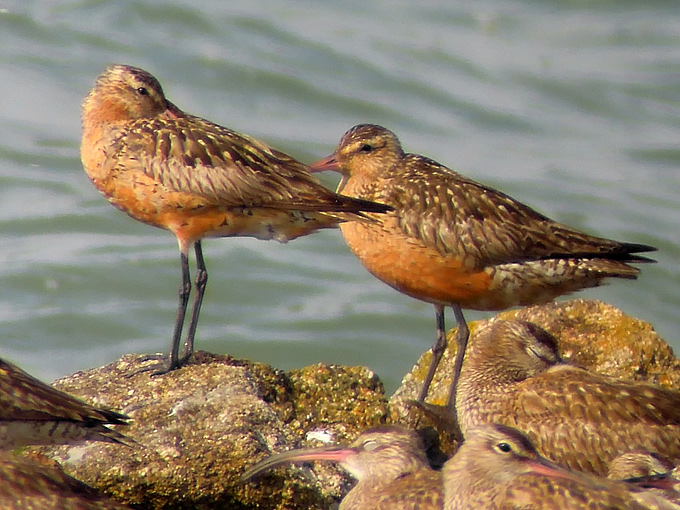

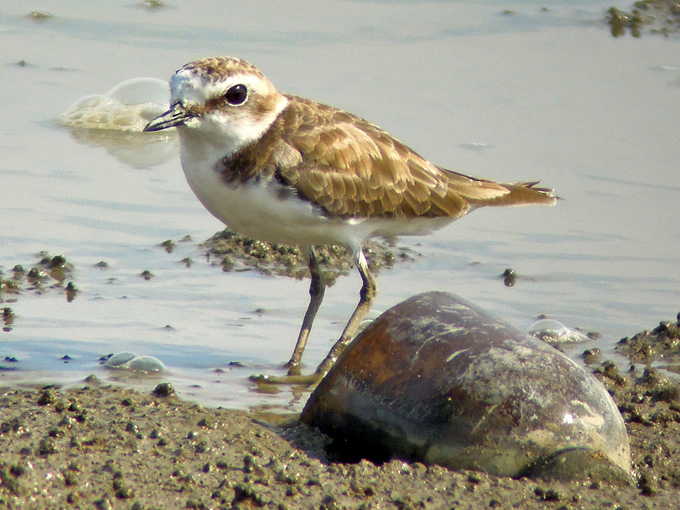
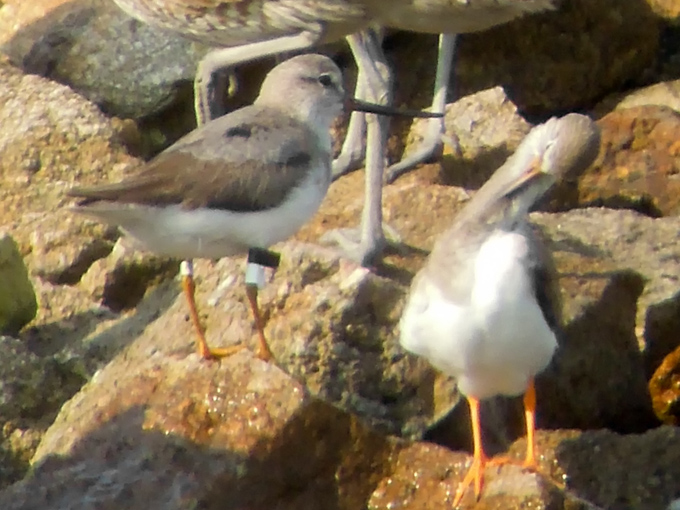
Back in Mokpo we went to the Namhang Urban Wetland at high-tide at its peak and so almost all birds were in one area of the site; exception were c. 40 Grey Heron and a few Great Egret which roosted all over the place and 1 Striated Heron and 2 Common Kingfisher were seen at one end of the site.
On shorebirds Red-necked Stint c. 350-400, Whimbrel 15, Pacific Golden Plover 5, Common Greenshank 40, Common Redshank 18, Grey-tailed-Tattler 25, Terek Sandpiper 40, Ruddy Turnstone, Marsh Sandpiper 5, Wood Sandpiper 20, Sharp-tailed Sandpiper 2, Broad-billed Sandpiper 2, Long-toed Stint and 4 Long-billed Plover 2 were seen with two additional highlights for the day: 1 juvenile Ruff (like the previous year) and the first time record for this site of 5 Red-necked Pharalope.



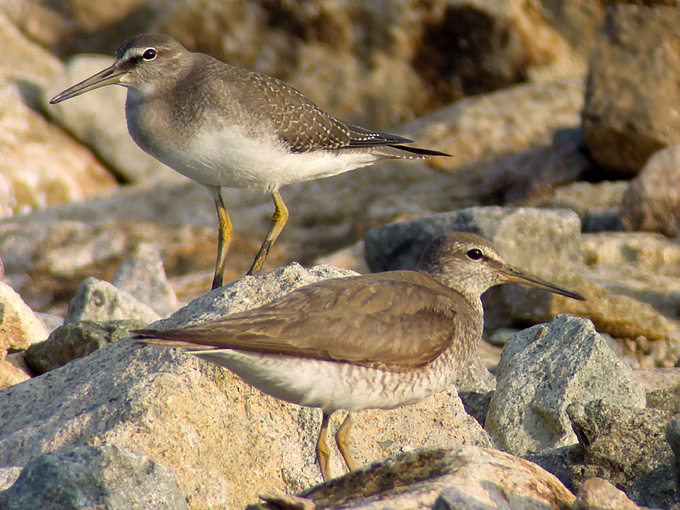


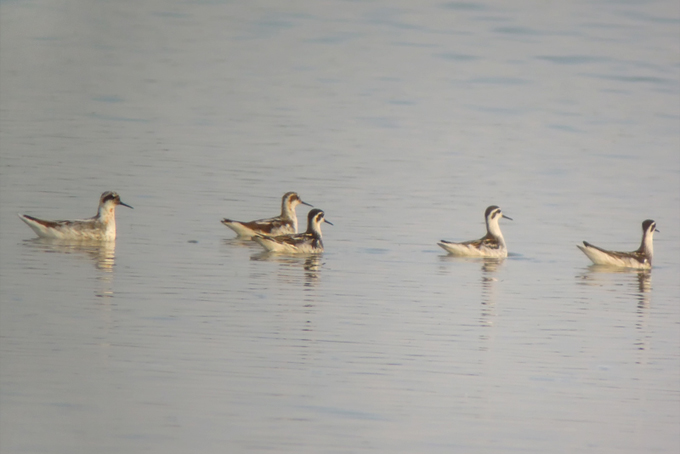
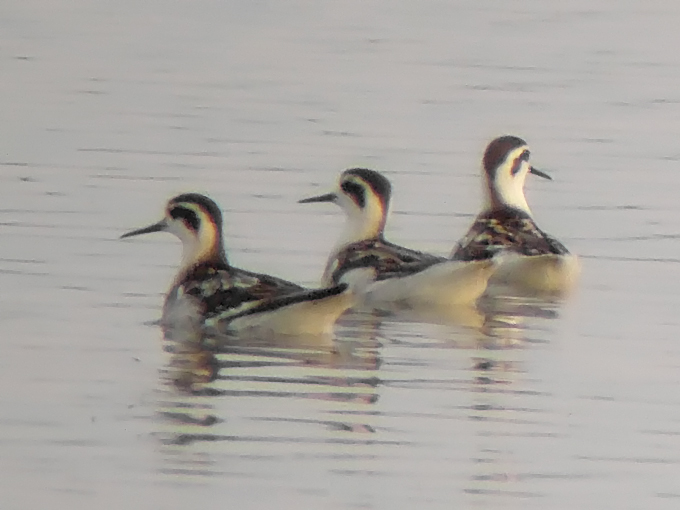

Suncheon Bay, August 30
I spent a pleasant morning around Suncheon Bay, wandering through the rice paddies in search of birds. I arrived a few hours after low tide, so shorebird numbers on the bay itself were lower than expected. The rice had not been harvested yet, except for one cell, which held a good number of shorebirds. There were some passerines around as well, including four counter-singing Far Eastern Cisticolas, singing Oriental Reed Warblers, and a few Eastern Yellow Wagtails passing through. Also observed a Least Weasel and an Amur Leopard Cat. A total of 35 bird species were observed throughout the day.
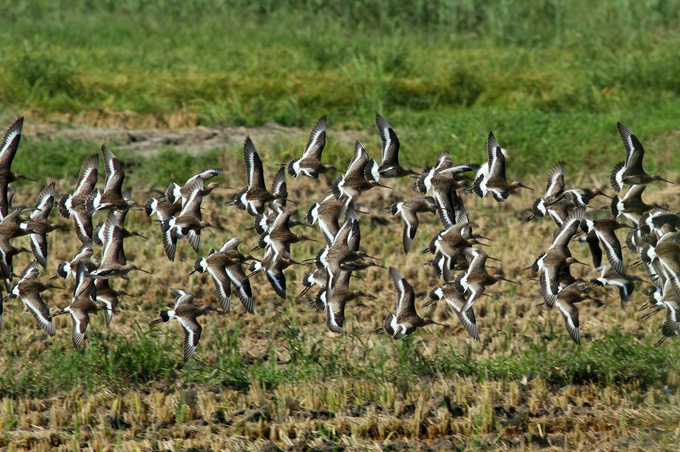



Mokpo Namhang Urban Wetland, August 27
The short visit after lunch found the site already complete filled with water even the high tide mark was about two hours later and so most birds were on roost. Heavy rain shower started short after arriving. Seen were c. 150 Black-tailed Gull, c. 40 Grey Heron, 4 Great Egret, 2 Little Egret, 21 Terek Sandpiper, one with black and white leg-flags, 16 Ruddy Turnstone, 13 Grey-tailed Tattler, 3 Common Redshank, c. 15 Common Greenshank, 5 Common Sandpiper, 3 Whimbrel, 2 Wood Sandpiper, 3 Long-billed Plover, several Barn Swallows circling over the water and a Common Kingfisher.




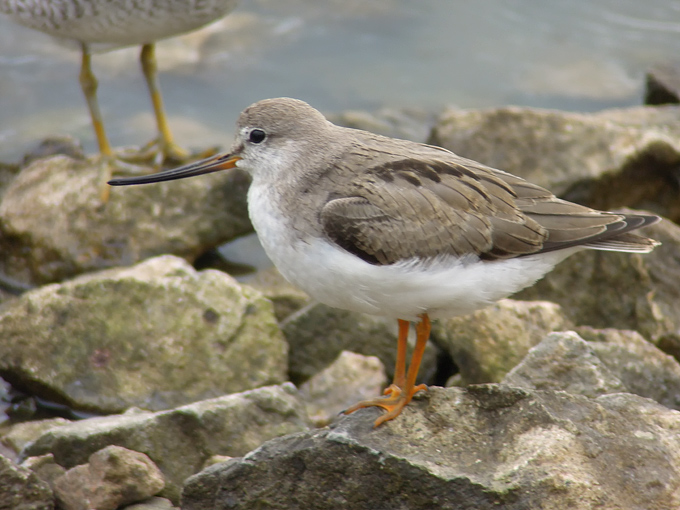

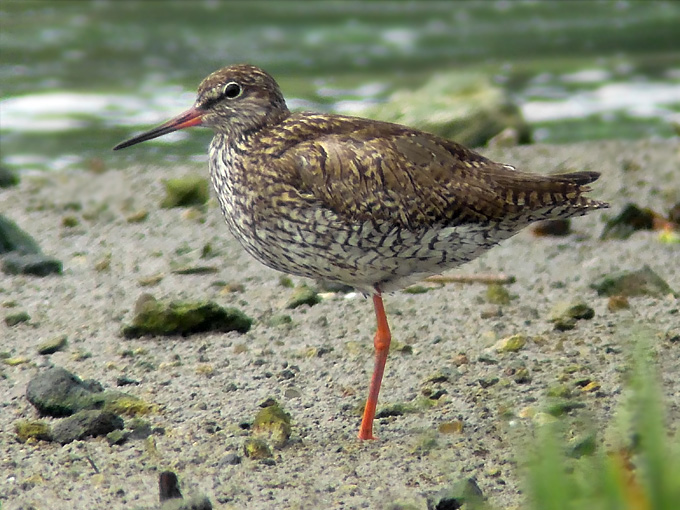

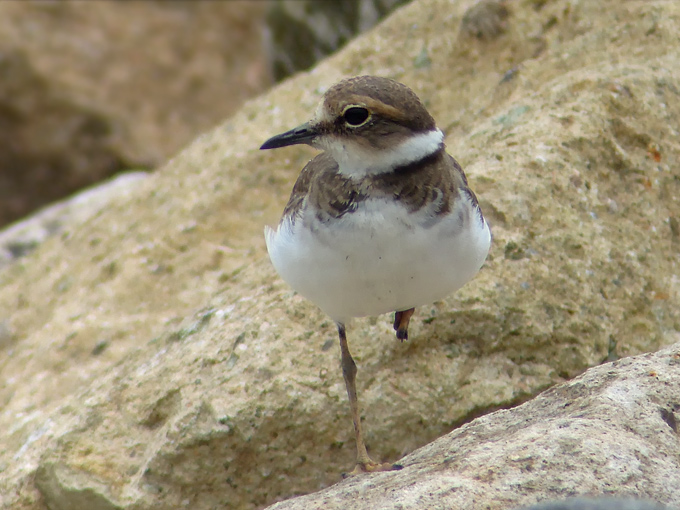
Haeundae, August 20 - 21
On the 20th, heavy rain fell for most of the day. Upon arriving at Jaeger Point, to avoid getting wet, I set up at a café, and for a little more than three hours had good views of the passing migrants all heading south into the wind. Within that time, I counted 900+ Common Tern, 54+ Red-necked Phalarope, 18 Black-headed Gull, two Garganey and 650+ shorebirds including mostly Great Knot, Terek Sandpiper, Whimbrel, a few Far Eastern Curlew and Eurasian Curlew, Grey-tailed Tattler, some Dunlin, Grey Plover, Pacific Golden Plover, Sanderling, and Red-necked Stint.
On the 21st, rain was forecast for the morning. Instead conditions were a mix of sunshine and occasional heavy showers early on, clearing by 9AM with moderate (Force 4) southerlies. Together with NM, we arrived at Jaeger Point before 0730. We counted c. 210 Common Tern, one Aleutian Tern (an adult moving into non-breeding plumage, with a hint of dark seen on the underside of the secondaries and a pale area on the inner primaries: NM only), 5 Red-necked Phalarope, close to 30 Black-headed Gull, a single Barn Swallow and between 30 – 40 other shorebirds including Whimbrel, Great Knot, two Sharp-tailed Sandpiper and some stints, all heading south. Close to 10am, some construction workers arrived at the headland apparently to close-off the best watchpoint. This was our cue to change positions and head to the third floor of a local café for a couple of hours. From there, we saw an Intermediate Egret, c. 80 more Common Tern (including one “dark” bird that on head-on views might, or might not have been an Aleutian)and a good mix of shorebirds including Green Sandpiper (1), Terek Sandpiper (12), Pacific Golden Plover (7), Grey Plover (c. 10), Mongolian Plover (1+), Kentish Plover (1), Red-necked Stint (8), Long-toed Stint (1), Dunlin (15), Great Knot (5+) and more Barn Swallow (13), again all heading south. There were a few Black-tailed Gull on the rocks, and briefly a juvenile Great Knot, but sadly few opportunities for digiscoping.

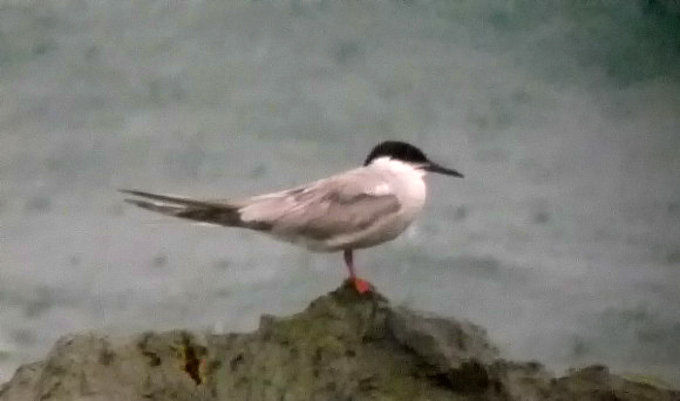

Haeundae, August 14
The temperature was surprisingly cool (around 20°), with strong winds and torrential rain drenching us for most of the morning. We positioned ourselves for seawatching at Jaeger Point, which is one of the northernmost headlands near Haeundae. There were birds on the move but not in high numbers. We saw between 50-100 Streaked Shearwater, 75-100 Common Tern, 1 White-winged Tern, 8 Whiskered Tern, about 15 Red-necked Phalarope, two Black-headed Gull, and the surprise of the morning were 6 Garganey in flight offshore. Grey-tailed Tattler and Common Sandpiper could be found on the rocky coastline. In the afternoon, at a patch along the Nakdong (JL only) were 2 Wood Sandpiper, 1 Common Tern, and 5 White-winged Tern feeding in a marshy pond. At the estuary there were Dunlin, Common Redshank, Terek Sandpiper, Red-necked Stint, Sanderling, and Common Greenshank.
Busan and the Guryongpo Pensinsula - August 9 & 10
Even though Typhoon Halong was centred off southern Japan, its influence was apparent in the southeast of the ROK. In strong northeasterlies during the late afternoon of the 9th, NM counted large numbers of birds (mostly Streaked Shearwater and Red-necked Phalarope and other shorebirds, containing one or two orange-bellied birds, perhaps Red Phalarope?) moving off Busan. With the wind forecast to switch to the north, NM and JL headed for the Guryongpo Peninsula on the 10th seawatching from about 0730-1330, and then searching for grounded migrants on the headland and the main southwestern beach until 1800.

Through the morning of the 10th, in heavy overcast with visibility ranging from 500m to 10km, moderate to strong northerlies and a large sea-swell, we found low thousands of birds trying to move around the Guryongpo Peninsula headland, with each pulse of rain and falling visibility producing waves of birds closer to shore. There were multiple exceptional highlights, but very few images because of the extremely poor conditions. Along with high numbers of Common Tern and Red-necked Phalarope, the morning’s highlights included a Sooty Shearwater (only one previous sight record nationally), a Bulwer’s Petrel (only 1 or 2 previous national records), probably six Aleutian Tern and two or three probable / presumed Arctic Tern (first national claim?). In the afternoon, as the weather brightened and the winds dropped, time was spent looking for migrant shorebirds (finding c.15 Whimbrel, 2+ Far Eastern Curlew, single Common Redshank, Terek and Broad-billed Sandpipers, 7+ Ruddy Turnstone, 10+ Grey-tailed Tattler, 30+ Sanderling, 10 Red-necked Stint, two Dunlin, 3+ Kentish and two Grey Plovers), distant terns and gulls (including 100s of Black-tailed Gull, 25+ Black-headed Gull, including several fresh juveniles, 9+ Slaty-backed Gull and one adult Vega Gull).
Details of selected highlights are as follows:
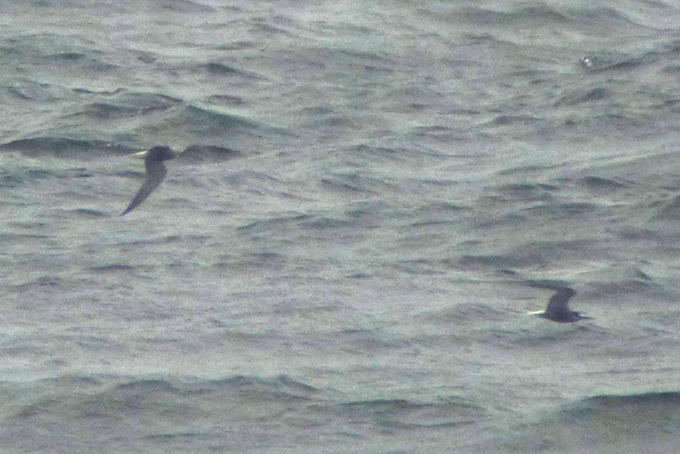
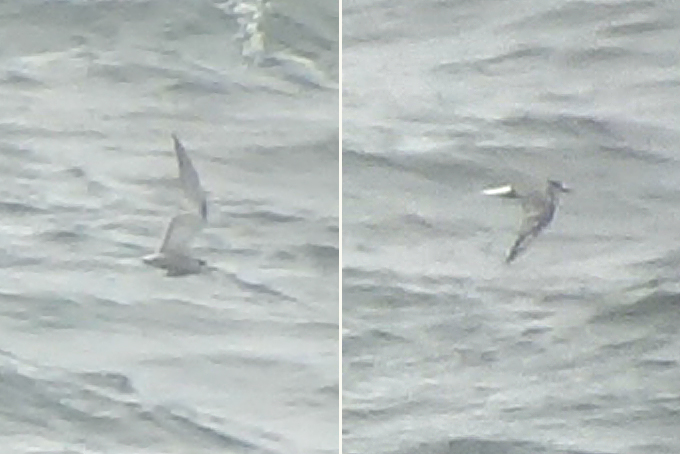


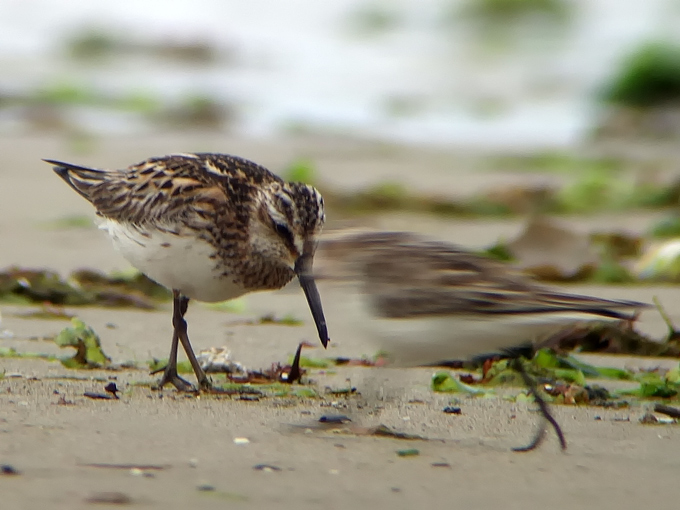
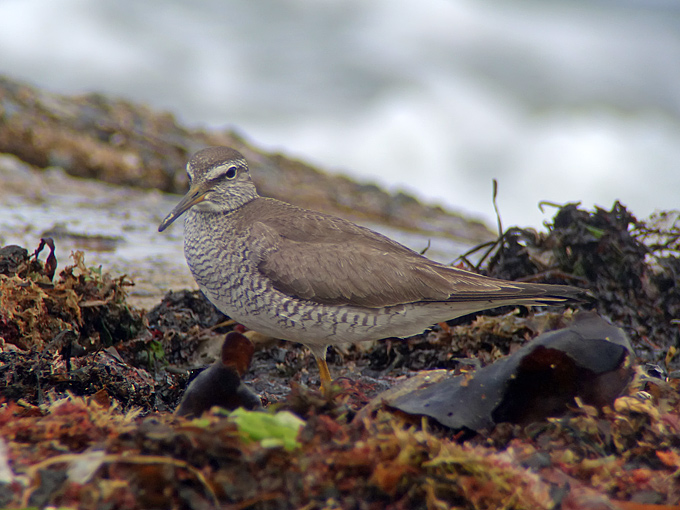

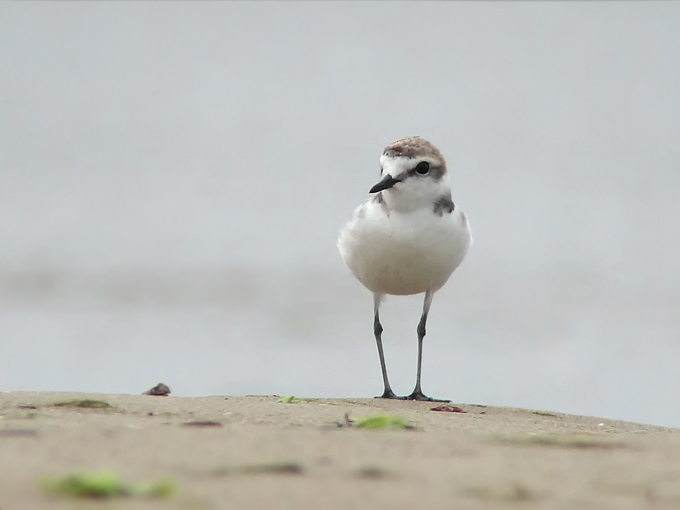



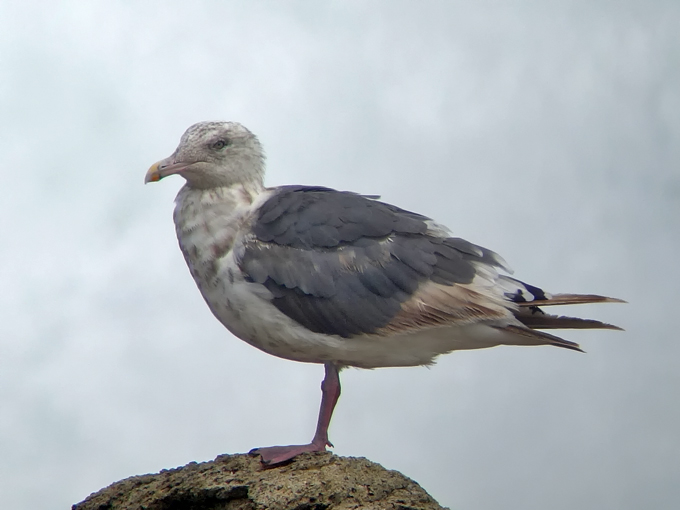
Mokpo Namhang Urban Wetland - August 4
For several days some shorebirds have returned to the site. This morning in heavy rain the number observed was smaller than the ones on the weekend by Dr. Kim because it was short after high tide and large areas of the tidal-flat was still under water. Due to the rain only the area along the street was quickly checked.
Non the less one Whimbrel, c. 20 Common Greenshank, 14 Ruddy Turnstone, 8 Grey-tailed Tattler, one Common Sandpiper, 5 Grey Heron, one Little Egret and c. 30 Black-tailed Gull were seen during the short walk by.

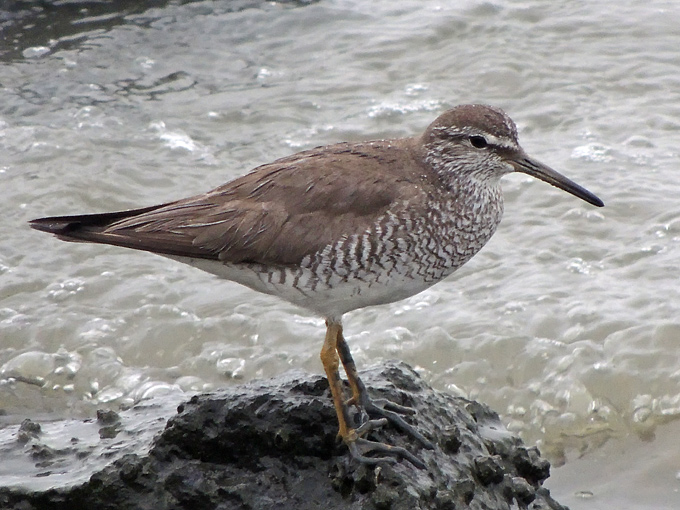
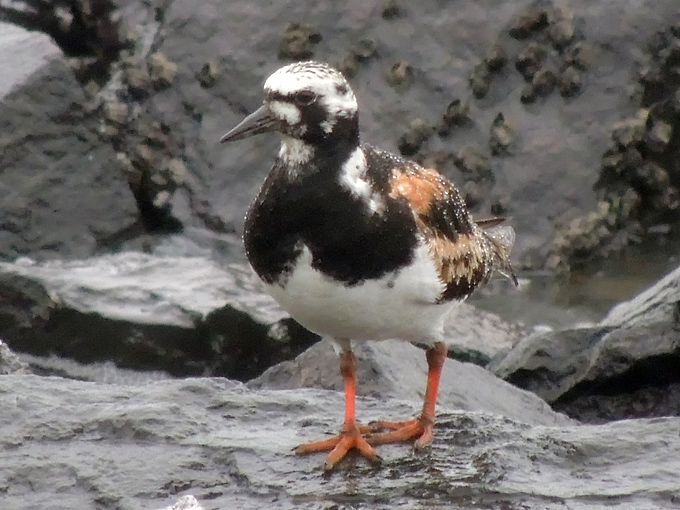



Songdo, July 27 - August 3
A surprising number of shorebirds were back at Songdo mudflats on 27 July. Subsequent visits over the next few dates to Gojan high tide roost revealed very variable numbers, indicating that the reclamation activities are probably affecting numbers as they find alternative roost sites in the area. Nearly all birds are in varying stages of summer (breeding) plumage.
Han River, August 2
Between Dokseo and Paldang, the following seemed noteworthy:
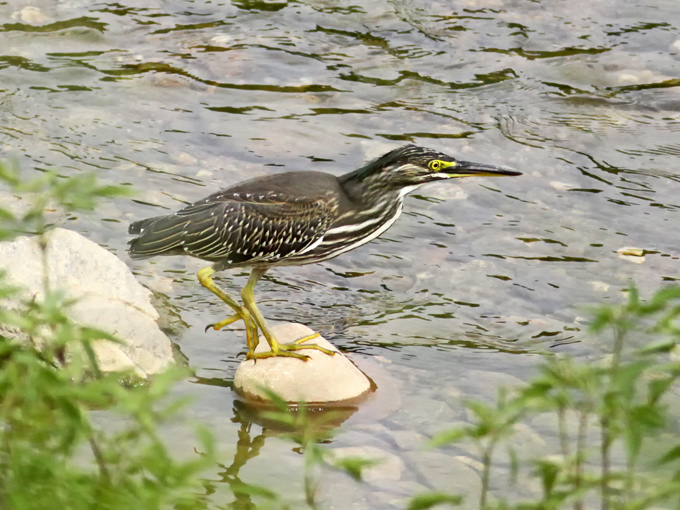

East Coast and Gangwon Province, July 30 - August 1
As part of research both for Birds Korea’s report (Status of Birds, 2014) and a report on the conservation of forest birds in Gangwon Province with the Hanns Seidel Foundation, we took a three day-trip starting from Busan. On July 30th, JL and NM visited the coast between Busan and Ulsan; the Guryongpo Peninsula; the river at Yeongdeok; the Jukpyeon headland north of Uljin; and the headland at Imwon. Joined by HJM on July 31st, we then hiked the trail up Seorak Mountain, from the Hangyerang Services at about 820masl to the shelter, just below Daecheongbong, at about 1600-1650masl. Apparently a White-throated Rockthrush has been heard along this trail this summer. On August 1st, we visited Sangwon Temple in Odae Mountain National Park, counting birds from a moving car along the road, before birding around the temple complex at about 900masl. We ended at Gangneung (birding the small, degraded and highly-disturbed but still bird-rich Namdaecheon Estuary) and the coast to the south of the city, where a Lesser Frigatebird had been seen a week before.


Most notable species included:








Birds Korea 1108 Ho, 3 Dong, Samick Tower Apt., 148-22, Namcheon-Dong, Su-Young-Gu
Busan, 618-762 Republic of Korea





